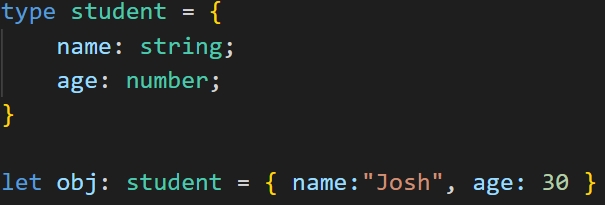
接續上一篇【前端筆記】 TypeScript 簡介(上)💫 ,我們再來了解其他常見的 TS 寫法。
目錄:
- 什麼是可選屬性(Optional Properties)、任意屬性(Indexable Types)、唯讀屬性(Readonly properties)
- 什麼是型別推論(Type Inference)與型別註記(Type Annotation)
- 怎麼寫類別 (Class)、泛型(Generic)
- 總結
什麼是可選屬性(Optional Properties)、任意屬性(Indexable Types)、唯讀屬性(Readonly properties)
🚀 可選屬性(Optional Properties)
當我們註記變數的型別後,在某些狀況下我們並不需要某個屬性時就可以利用 ? 來表示,例如以下例子,我們用型別別名 type 來宣告型別並宣告變數,可以看到 TStudent2 的 age 多了一個 ? ,因此 obj2 沒有 age 也不會像 obj 出錯
type TStudent = {
name: string
age: number
}
const obj: TStudent = {
name: 'Josh',
}
// Property 'age' is missing in type '{ name: string; }' but required in type 'TStudent'.
type TStudent2 = {
name: string
age?: number
}
const obj2: TStudent2 = {
name: 'Amber',
}
🚀 任意屬性(Indexable Types)
我們只知道某些屬性的型別,不曉得其他屬性的型別時用 [x: type]: type 可確保型別的彈性
type TStudent = {
name: string
age: number
[x: string]: any
}
const obj: TStudent = {
name: 'Josh',
age: 30,
address: 'hihiroad',
}
⚠ 使用任意屬性需注意的事情
倘若任意屬性為「特定」型別 (非 any 或 unknown),要注意的是所有宣告的屬性(包括確定和可選屬性)都必須是「特定」型別的子屬性
如以上例子,若你的任意屬性為any,那並不會影響其他屬性,但若你將其改成特定型別,如 string,則 age屬性會有錯,因為age的型別為 number,不是 string的子屬性
type TStudent = {
name: string
age?: number
[x: string]: string
}
// Property 'age' of type 'number' is not assignable to 'string' index type 'string'.
const obj: TStudent = {
name: 'Josh',
age: 30,
address: 'hihiroad',
}
// Type '{ name: string; number: number; address: string; }' is not assignable to type 'TStudent'.
// Property 'age' is incompatible with index signature.
// Type 'number' is not assignable to type 'string'.
可以加上 number | undefined 來處理此錯誤
type TStudent = {
name: string
age?: number
[x: string]: string | number | undefined
}
const obj: TStudent = {
name: 'Josh',
age: 30,
address: 'hihiroad',
}
🚀 唯讀屬性(Readonly properties)
利用此屬性代表你在賦值後,就再也不能改變其值了,用法是在屬性前面加上 readonly
type TStudent = {
readonly name: string
age?: number
}
const obj: TStudent = {
name: 'Josh',
age: 30,
}
obj.name = 'Joseph' // Cannot assign to 'name' because it is a read-only property.
obj.age = 28
什麼是型別推論(Type Inference)與型別註記(Type Annotation)
🚀 型別推論(Type Inference)
是 TS 自你開始開發的時候,會幫你判別變數型別,如以下,若你沒宣告 student 型別,TS 會自動幫你判別

🚀 型別註記(Type Annotation)
為開發者手動宣告給 TS 看的註記,就是一般的寫法

之所以你需要宣告型別,其好處在於在讓開發者/協作者可以明確知道變數是哪個型別,才不會讓 TS 或開發時去猜那個屬性是什麼型別而造成程式碼的混亂

🚀 型別斷言 (Type Assertions)
主要用於 TS 幫你做型別推論後,你不滿足其 TS 對於此型別的限制,因此手動去宣告覆蓋它的推斷。使用時機像是你不確定資料會是哪種型別時,如在串接 api 、串接第三方函式等等的,有兩種寫法:
值 as 型別 (React 專案使用 JSX 語法,只能用此寫法)
<型別>值
例如以下的例子,typeof animal.swim 是會報錯的,因為若是 Cat型別,是沒有 swim 這個屬性
interface Cat {
name: string;
run(): void;
}
interface Fish {
name: string;
swim(): void;
}
function isFish(animal: Cat | Fish) {
if (typeof animal.swim === 'function') {
return true;
}
return false;
}
// Property 'swim' does not exist on type 'Cat | Fish'.
// Property 'swim' does not exist on type 'Cat'.
因此會需要加上斷言就不會報錯,直接告訴 TS animal 在那邊的型別
function isFish(animal: Cat | Fish) {
if (typeof (<Fish>animal).swim === 'function') {
return true;
}
return false;
}
另一個例子是接 api 後的斷言 (要先裝 axios,npm i axios),data1就能被斷言成 Data的型別
import axios from 'axios';
type Data = {
userId: number
id: number
title: string
completed: boolean
}
async function getData() {
const res = await axios.get('https://jsonplaceholder.typicode.com/todos/1')
const data1 = await res.data as Data // 斷言其為 Data type
console.log(data1) // { userId: 1, id: 1, title: 'delectus aut autem', completed: false }
}
getData()
怎麼寫類別 (Class)、泛型(Generic)
🚀類別 (Class)
我們可以對於屬性、constructor、方法加上型別
class User {
name: string
private age: number
protected adress: string
constructor(name: string, age: number, adress: string) {
this.name = name;
this.age = age;
this.adress = adress;
}
sayHi(): string {
return `Hi, ${this.name}, your age is ${this.age}`;
}
}
const user1 = new User('david', 20, 'david road')
console.log(user1) // User { name: 'david', age: 20, adress: 'david road' }
console.log(user1.sayHi()) // Hi, david, your age is 20
可以注意到我們透過 private/ protected 來加註在屬性上,他們皆有一個特性是你不能從外部直接訪問 ( 如以下錯誤),但差別是 private 是只可以在該 Class 來讀取,你無法繼承來使用, protected 可以在該 Class 來讀取,也可以透過繼承來使用
console.log(user1.age)
// Property 'age' is private and only accessible within class 'User'.
console.log(user1.adress)
// Property 'adress' is protected and only accessible within class 'User' and its subclasses.
利用 extends 來擴展/繼承
class Student extends User {
grade: number
constructor(name: string, age: number, adress: string, grade: number) {
super(name, age, adress) // 在這裡執行的 super 等同於父類別的 constructor
this.grade = grade;
}
sayGrade(): string {
return `Hi, ${this.name}, your grade is ${this.grade}`;
}
}
const student1 = new Student('JoJo', 21, 'JoJo road', 2)
console.log(student1) // Student { name: 'JoJo', age: 21, adress: 'JoJo road', grade: 2 }
console.log(student1.sayGrade()) // Hi, JoJo, your grade is 2
🚀泛型(Generic)
主要是指在定義函式、介面或類別的時候,不先宣告型別,而在使用的時候再宣告,如以下利用 <T> 來宣告為使用時才會傳入的型別
function printName<T> (name: T) {
return `Your name is ${name}`
}
console.log(printName<string>('Josh'))
// Your name is Josh
若需要多個型別引數,可利用不同的文字做宣告
function printNameAge<T, U> (name: T, age: U) {
return `Your name is ${name} and age is ${age}`
}
console.log(printNameAge<string, number>('Josh', 30))
// Your name is Josh and age is 30
總結
雖然分為上下兩篇來介紹 TS,但還是有很多沒介紹到,不過這些寫法都是工作上常見的,其他大概都是由這些東西加以延伸,TS 最主要的工作讓我們在開發 JS 的時候就知道哪些是不合理的型別,因此大大減少運行時發生錯誤的機率,不過有一好沒兩好,在開發上你總還是要花額外的時間來定義各種型別,總之,若想繼續往下探究 TS 的朋友可參考以下文章,或者可以直接看官方文件:Generics
